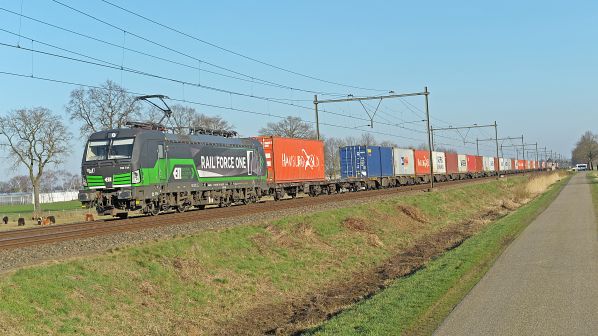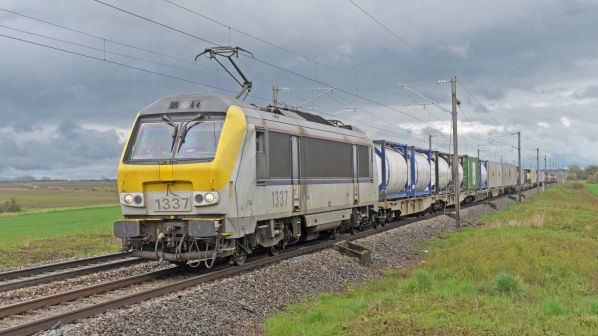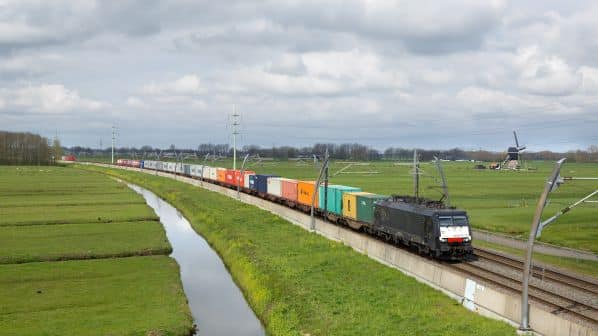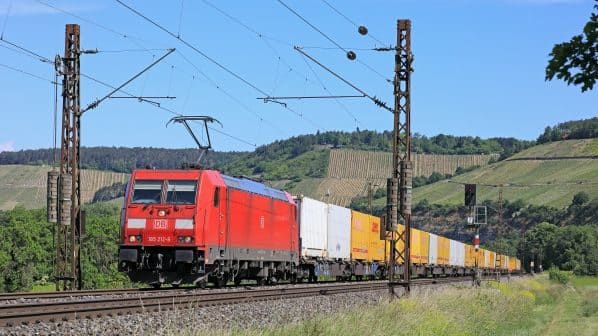IMPROVED rail infrastructure management, stronger incentives for low-emissions lorries, and better information on freight transport’s greenhouse gas emissions are at the centre of the Green Transport Package, three new legislative proposals by the European Commission (EC) aimed at improving freight efficiency in Europe.
The EC describes the proposals as part of a broader effort to make transport more sustainable, following on from the key components of its Fit for 55 package. They are also described as a key action under the European Green Deal and the Sustainable and Smart Mobility Strategy, which aims to increase rail freight volumes by 50% by 2030 and 100% by 2050.
Infrastructure management
With an increasing proportion of the European Union’s (EU) railway network suffering from congestion and unable to accommodate the capacity requirements of all applicants for paths, the future growth of railway traffic deemed necessary to deliver the decarbonisation of transport is under threat.
The EC is therefore proposing to replace the existing framework, which dates from 2012, with a more flexible and effective method for capacity and traffic management, which it says will increase both the quality of available services and use of the continent’s railway network, supporting decarbonisation.
The proposal builds on work conducted by the sector on the Timetable Redesign for Smart Capacity Management Project (TTR), which aims to address the weaknesses in the current processes for managing infrastructure capacity and rail traffic, with the proposal in effect providing a legal framework for its full introduction.
In practice, the EC says adoption will result in more stable timetables, passengers being able to make earlier ticket bookings, and greater flexibility in timetabling to suit freight shippers with just-in-time supply chains. Increased capacity will also offer further opportunities for new operators to enter the market.
The proposal states that to ensure that capacity is available for all different rail market segments, especially for freight and cross-border services, infrastructure managers (IMs) should be allowed to pre-plan the use of capacity on congested or intensively-used sections of the network and to extend this to other sections if deemed necessary.
“This pre-planning of capacity should take into account the different methods for capacity allocation and the characteristics of different rail market segments,” the proposal says. “It should allow for better utilisation of rail infrastructure by grouping trains with similar performance characteristics in the capacity allocation phase.”
Under the proposal, operators will be able to request and receive paths at any time, based on market needs. Indeed, as well as accommodating requests for capacity on an annual basis through the working timetable, the proposal states that IMs must be alert to the needs of freight operators unable to identify their capacity needs in time to be included in the working timetable.
Under the new “rolling planning” concept, IMs will be required to reserve and offer capacity of sufficient quantity and quality for rail services that may have unstable levels of demand, are organised at relatively short notice, include more than a single train run, and may run repeatedly for a period of time that may not coincide with the duration of the working timetable period.
This planning process includes the early integration of maintenance work, which the EC says will reduce disruption to services and improve performance. In addition, the new framework is expected to improve the response to network disruption and major incidents affecting rail services through the early identification of capacity bottlenecks and by improving the ability to introduce countermeasures and more effective on-time solutions.

To improve cross-border traffic, the proposal calls for the harmonisation of the rules and procedures governing the management of rail infrastructure capacity. The proposal states that the role of European Network of Infrastructure Managers (ENIM) should be strengthened with a view to entrusting it with the development and implementation of procedures and methodologies to manage capacity and coordinate cross-border capacity and traffic. It is also necessary to provide structured coordination between IMs and operators using the network, including by improving data exchange between IMs. The deployment of interoperable digital tools and increased automation is considered a priority.
The proposal also calls for the establishment of a Performance Review Body (PRB) to provide advice to the EC on all areas that influence the performance of rail services and infrastructure management. The PRB should establish a common framework to review performance and ensure that IMs use common principles and methodologies to measure performance through agreed indicators, helping to identify deficiencies in network performance.
Interestingly, the EC is stepping back from the 2010 Rail Freight Corridors Regulation by abolishing the corridor concept for capacity management but retaining and further developing what it describes as the positive elements of the regulation. It says the results of this exercise have been unsatisfactory as managing capacity on a corridor basis does not reflect how freight trains typically operate. In addition, the growing focus on cross-border services compounds the problem as passenger and freight flows do not always coincide.
Low-emissions lorries
The transport package also includes proposals to adjust the current Weights and Dimensions Directive for heavy goods vehicles by increasing the allowed weight and size of lorries using zero-emissions technologies. The EC says this will incentivise the take-up of cleaner vehicles and technologies. The proposal also provides clarity on the use of heavier and longer vehicles in cross-border traffic, including allowing European Modular Systems, combining individual road units into longer vehicles and which are permitted in some states, in cross-border operation. The EC says this will enable more freight to be carried with fewer lorry movements.
The proposal also seeks to encourage intermodal transport by allowing lorries, trailers and semi-trailers to carry extra weight while extended height limits will enable the transport of high-cube containers by standard vehicles. The EC has confirmed that it will revise the Combined Transport Directive later this month. This document dates from 1992 but efforts to update it in recent years have failed, much to the frustration of those seeking to develop intermodal freight.
Carbon reporting
The EC is proposing a common methodological approach for companies to calculate their greenhouse gas emissions. CountEmissions EU is based on the recently adopted ISO/CEN standard and will enable operators to benchmark their services, allowing consumers to make informed decisions on transport and delivery options.
Industry response
The proposals for reforming capacity allocation have been broadly welcomed by the railway sector.
The Community of European Railways and Infrastructure Companies (CER) describes the regulation on the use of railway infrastructure capacity in the Single European Railway Area as a “timely piece of legislation long advocated by the railway sector.” It says the sector lacked the freedom under the “current overly rigid legal framework” to tackle the challenges of capacity coordination between neighbouring countries and beyond.
“CER therefore welcomes this proposal and supports the legal backbone of TTR,” CER said in a statement. “This will provide the grounds for efficient and optimal capacity management - paving the way for digital capacity management - and will address the current lack of harmonisation, synchronisation and coordination of capacity allocation processes in the EU.”
CER says that it particularly welcomes the inclusion of the rolling planning concept. It adds that IMs will continue their close cooperation within a revitalised ENIM “to make optimum effective use of available rail infrastructure capacity” and jointly develop a European framework for capacity management and for coordination of traffic and incident management.
“With the new legislation on capacity, the sector expects positive effects on long-term scheduling for passenger services and more flexibility on short-term capacity allocation for freight services,” CER says. “The first concrete results could already be delivered by 2025, which is why CER calls on legislators to fast-track the proposal.”
The association is, however, critical of the proposal to permit longer and heavier road vehicles, a position shared with the European Rail Freight Association (ERFA). ERFA says revision of the Weights and Dimensions Directive must be carried out in conjunction with revision of the Combined Transport Directive. “Both texts must ensure the interoperability of road and rail freight transport as well as fair competition between transport modes,” ERFA says.
CER says it has “grave concerns” that allowing longer and heavier road vehicles will have the unintended consequence of reversing the modal shift that is so badly needed to achieve the ambitious objectives of the EU's Sustainable and Smart Mobility Strategy.
Next steps
The proposals will now be considered by the European Parliament and the Council under the conventional legislative procedure.
ERFA and CER have urged swift adoption, especially as elections for the European Parliament are taking place next year. They also encourage legislators to adopt measures that complement the objectives of other pending legislation, notably the revisions to the Combined Transport Directive and the upcoming Trans-European Transport Network (TEN-T) Regulation.
“If the European Parliament and Council are serious about growing rail freight and reducing freight transport emissions, we need an ambitious approach on this package,” says Mr Dirk Stahl, ERFA president and CEO of BLS Cargo. “We need to urgently move towards a more international and user-friendly railway system. These proposals have an important role to play.”




